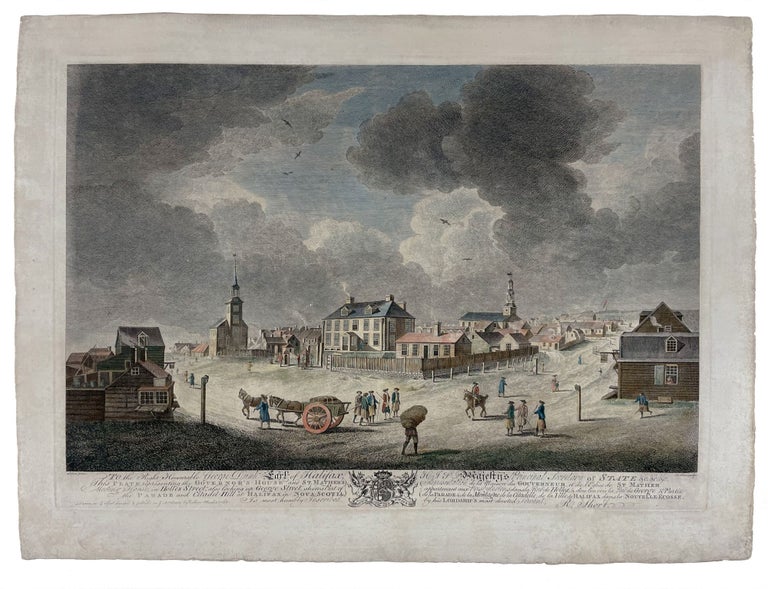SHORT, Richard
To the Right Honourable George Dunk Earl of Halifax...This Plate representing the Governor's House and St. Mather's Meeting House, in Holles Street, also looking up George Street shews Part of the parade and Citadel-Hill at Halifax in Nova Scotia
R. Short, 1764. Engraving, after Dominique Serres painting of Richard Short's drawing, engraved by Aveline. Captioned in English and French, with the arms of the Earl of Halifax. Sheet size: (17 1/4 x 23 1/8 inches).
An important and very rare print from a "fine set ... most important historically" (Spendlove).
Richard Short was purser onboard H.M.S. Prince of Orange, and served at the siege of Quebec in 1759. Clearly, he was allowed a certain amount of lee-way, for in addition to his commissioned drawings of Quebec, he also had time enough to produce a series of views of Halifax, the main anchorage for the British fleet. Short's Halifax drawings were evidently worked up into paintings by Dominique Serres, Marine Painter to George III and an artist of considerable reputation and ability, and then engraved by a number of well-known and highly talented London engravers and the resulting six plates originally published by Short himself in 1761. Spendlove writes of the series: "the composition and design of the pictures is pleasing, perspective is good, and buildings are extremely well handled. Human figures are done convincingly and show action ... they constitute a fine set of prints [and are] ... most important historically." This plate shows notable Halifax locations such as the Governor's House, St. Mather's meeting house, Holles Street and George Street. The Governor's House held significant importance as the official residence of the British governor and served as the center of colonial administration in Halifax. It represented British authority and played a vital role in governing the region. Meanwhile, the St. Mather's Meeting House, or St. Matthew's United Church, played a significant role in the religious and community life of Halifax. Later, the 19th century saw the continued importance of the church, but with the growth of Halifax and the arrival of new religious denominations, the dynamics of religious life in the city changed. St. Mather's Meeting House evolved into St. Matthew's United Church, reflecting the merger of different congregations. The streets depicted here represent the early stages of Halifax's urban expansion and would come to reflect the changing urban fabric and evolving tastes of Halifax residents. Looking up George Street, Citadel Hill is visible. It served as a strategically located fortification and military garrison for the British and played a vital role in defending Halifax, safeguarding British interests, and maintaining control over the region, contributing to the city's growth and serving as a symbol of British military presence in North America.
Spendlove, The Face of Early Canada (1958) pp. 11-12.
Item #38371
Price: $8,500.00


